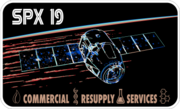 Dragon C106.3 approaches the ISS | |
| Names | SpX-19 |
|---|---|
| Mission type | ISS resupply |
| Operator | SpaceX |
| COSPAR ID | 2019-083A |
| SATCAT no. | 44821 |
| Mission duration | 32 days, 22 hours, 12 minutes |
| Spacecraft properties | |
| Spacecraft | Dragon 1 C106 |
| Spacecraft type | Dragon 1 |
| Manufacturer | SpaceX |
| Dry mass | 4,200 kg (9,300 lb) |
| Dimensions | Height: 6.1 m (20 ft) Diameter: 3.7 m (12 ft) |
| Start of mission | |
| Launch date | 5 December 2019, 17:29:24 UTC[1] |
| Rocket | Falcon 9 Block 5 (B1059.1) |
| Launch site | Cape Canaveral, SLC-40 |
| End of mission | |
| Disposal | Recovered |
| Landing date | 7 January 2020, 15:42 UTC[2] |
| Landing site | Pacific Ocean |
| Orbital parameters | |
| Reference system | Geocentric |
| Regime | Low Earth |
| Inclination | 51.6° |
| Berthing at ISS | |
| Berthing port | Harmony nadir[3] |
| RMS capture | 8 December 2019, 10:05 UTC[4] |
| Berthing date | 8 December 2019, 12:47 UTC[3] |
| Unberthing date | 7 January 2020, 08:41 UTC |
| RMS release | 7 January 2020, 10:05 UTC[2] |
| Time berthed | 29 days, 19 hours, 54 minutes |
| Cargo | |
| Mass | 2,617 kg (5,769 lb)[5] |
| Pressurised | 1,693 kg (3,732 lb)[5] |
| Unpressurised | 924 kg (2,037 lb)[5] |
 SpaceX CRS-19 mission patch | |
SpaceX CRS-19, also known as SpX-19, was a Commercial Resupply Service mission to the International Space Station.[6] The mission is contracted by NASA and was flown by SpaceX on a Falcon 9 rocket.
Dragon capsule C106 made its third flight on CRS-19 having previously flown on CRS-4 and CRS-11. Dragon successfully returned to Earth on 7 January 2020 after a month-long stay at the ISS.
- ^ Clark, Stephen (5 December 2019). "Dragon soars on research and resupply flight to International Space Station". Spaceflight Now. Retrieved 19 October 2020.
- ^ a b Clark, Stephen (7 January 2020). "Dragon cargo capsule brings home space station science experiments". Spaceflight Now. Retrieved 19 October 2020.
- ^ a b Garcia, Mark (8 December 2019). "Dragon Attached to Station for Month-Long Stay". NASA. Retrieved 19 October 2020.
- ^ Garcia, Mark (8 December 2019). "Astronauts Capture Dragon Filled With Brand New Science". NASA. Archived from the original on 23 October 2020. Retrieved 19 October 2020.
- ^ a b c "Overview: SpaceX CRS-19 Mission" (PDF). NASA. Retrieved 19 October 2020.
- ^ Cite error: The named reference
sfn-schedulewas invoked but never defined (see the help page).